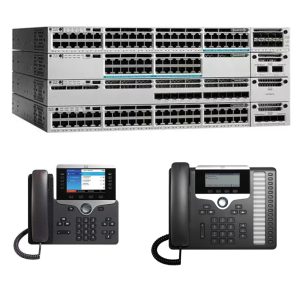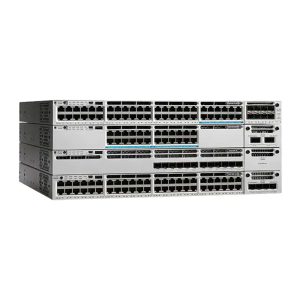Introduction to CISCO Catalyst 9500
CISCO Catalyst 9500 is a high-end series of switches designed for enterprise networks. These switches offer a range of features that help organizations to build and maintain reliable, secure, and scalable networks. Furthermore, they are designed to deliver exceptional performance, and to provide advanced security features that help to keep networks safe from threats.
Key Features of CISCO Catalyst 9500
High-Performance Switching The CISCO Catalyst 9500 series switches are designed for high-performance switching, with a backplane architecture that provides up to 960 Gbps of throughput. This allows organizations to handle large amounts of network traffic, ensuring that applications and services run smoothly.
Advanced Security CISCO Catalyst 9500 switches are equipped with advanced security features that help to protect networks from threats. These features include threat defense, access control, and encryption. The switches also offer security features that help to prevent data breaches and protect against unauthorized access to sensitive information.
Scalability and Flexibility The CISCO Catalyst 9500 switches are designed for scalability and flexibility, allowing organizations to easily expand their networks as needed. The switches offer a range of interfaces, including 10 Gigabit Ethernet, 40 Gigabit Ethernet, and 100 Gigabit Ethernet.
Energy-Efficient Design The CISCO Catalyst 9500 switches are designed with energy efficiency in mind, and they offer a range of features that help to reduce power consumption. These features include advanced power management, energy-efficient Ethernet, and more.
Application Visibility and Control The CISCO Catalyst 9500 switches offer application visibility and control, allowing organizations to monitor and manage network traffic. This helps organizations to ensure that applications and services are running smoothly, and to resolve any performance issues that may arise.
Benefits of CISCO Catalyst 9500
Improved Network Performance By using Catalyst 9500 switches, organizations can improve network performance, ensuring that applications and services run smoothly. The high-performance switching and advanced security features help to ensure that networks are reliable, secure, and scalable.
Enhanced Security The advanced security features of Catalyst 9500 switches help to protect networks from threats, ensuring that sensitive information remains secure. The switches also help to prevent data breaches and unauthorized access to sensitive information.
Increased Scalability and Flexibility The scalability and flexibility of CISCO Catalyst 9500 switches make it easy for organizations to expand their networks as needed. This helps organizations to grow and adapt to changing business needs, and to take advantage of new technologies.
Energy Efficiency The energy-efficient design of Catalyst 9500 switches helps organizations to reduce power consumption, saving money on energy costs and reducing their environmental impact.
Improved Network Visibility and Control The application visibility and control features of Catalyst 9500 switches help organizations to monitor and manage network traffic, ensuring that applications and services are running smoothly. As a result this helps organizations to resolve any performance issues that may arise, and to improve network performance overall.
Advanced Security Features of CISCO Catalyst 9500
The Catalyst 9500 series switches are a key component of modern networking infrastructure. Designed with cutting-edge security features, these switches are ideal for organizations of all sizes that require reliable, high-performance networking solutions. Whether you’re looking to protect against cyber threats, ensure compliance with industry standards, or simply improve overall network security, the Cisco Catalyst 9500 series has you covered.
1. Enhanced Security through Advanced Threat Detection
One of the key advantages of the Catalyst 9500 series is its advanced threat detection capabilities. With a combination of hardware-based security features, such as network segmentation, and software-based security features, such as intrusion prevention systems (IPS), the Cisco Catalyst 9500 series provides a comprehensive defense against cyber attacks. As a result, this helps organizations to detect and prevent security breaches before they occur, reducing the risk of data loss and ensuring that their networks remain secure.
2. Compliance with Industry Standards
In addition to its advanced threat detection capabilities, the Cisco Catalyst 9500 series also helps organizations to comply with industry standards. With built-in support for key security standards, such as the Payment Card Industry Data Security Standard (PCI DSS) and the Health Insurance Portability and Accountability Act (HIPAA), the Cisco Catalyst 9500 series ensures that organizations are meeting the strictest standards for network security.
3. Network Segmentation
Another key feature of the Cisco Catalyst 9500 series is network segmentation. This allows organizations to separate critical network segments, such as those used for financial transactions or sensitive information, from less critical network segments. As a result, this helps to reduce the risk of data loss or theft and ensures that confidential information is protected.
4. Advanced Network Security Management
In addition to its hardware-based security features, the Cisco Catalyst 9500 series also provides advanced network security management. Moreover, with built-in support for Cisco’s Security Manager and Identity Services Engine (ISE), the Cisco Catalyst 9500 series provides organizations with the ability to manage network security policies and ensure that they are being followed. This helps to ensure that organizations are meeting their security obligations and that their networks remain secure.
5. Robust and Reliable
In addition to its security features, the Catalyst 9500 series is also robust and reliable. The Catalyst 9500 comes with built-in redundancy and high-availability features. As a result, it ensures that networks remain up and running even in the event of hardware failure. This helps to reduce downtime and ensure that organizations can continue to operate effectively.
Scalability and Flexibility
As the demand for advanced technology in the modern business world increases, so does the need for high-performance network solutions that can support the ever-evolving needs of organizations. Catalyst 9500 is a perfect example of a network solution that delivers exceptional performance, scalability, and flexibility. This makes it one of the best choices for businesses looking to upgrade their infrastructure.
The switch supports a variety of interfaces, including Ethernet, Fibre Channel, and Application Visibility and Control (AVC), making it easy for organizations to connect their devices and applications. It features a modular architecture. This enables organizations to easily add or remove components as their needs change. As a result the overall network expenditure remains at a minimum.
The switch can also be deployed in a variety of environments, including data centers, campus networks, and branch offices, allowing organizations to use it in a way that best fits their needs and scale their network as their requirements change over time.
Basic Configuration Catalyst 9500
The configuration of the Cisco Catalyst 9500 Series can be accomplished using either the Command Line Interface (CLI) or the Web-based Graphical User Interface (GUI). In this section, we will provide a step-by-step guide to configuring the Cisco Catalyst 9500 Series using the CLI.
Step 1: Connecting to the Switch
The first step in configuring the Cisco Catalyst 9500 Series is to connect to the switch using a console or Telnet connection. Once connected, you will be prompted to enter your username and password to log in to the switch.
The default username is webui and password cisco.
Step 2: Configuring Basic Settings
Once logged in, you can start to configure the basic settings for the switch. This includes setting the hostname, IP address, subnet mask, and default gateway for the switch. These settings can be configured using the following commands:
switch(config)# hostname <hostname>
switch(config)# interface <interface>
switch(config-if)# ip address <IP address> <subnet mask>
switch(config-if)# no shutdown
switch(config)# ip default-gateway <default gateway IP>
VLAN Configuration
A VLAN is a logical segmentation of a network that separates network traffic and broadcasts into separate groups. As a result, this allows you to create multiple isolated networks on a single switch or multiple switches. Moreover, this improves network security and performance. VLANs are created by assigning unique VLAN IDs to each group of switch ports, which then belong to a specific VLAN.
Prerequisites
Before you begin configuring VLANs on a Catalyst 9500 switch, you should have the following prerequisites in place:
- Access to the switch’s command-line interface (CLI)
- Knowledge of basic networking concepts
- Understanding of VLANs and their functionality
Step 1: Configure VLANs
Firstly, to configure VLANs on a Catalyst 9500 switch, you need to create the VLANs themselves. To create a VLAN, you will use the following CLI command:
switch(config)# vlan [VLAN_ID]
Replace [VLAN_ID] with the desired VLAN ID number. For example, to create a VLAN with ID 10, you would enter the following command:
switch(config)# vlan 10
Step 2: Assign Switch Ports to VLANs
Once you have created your VLANs, you can then assign switch ports to the appropriate VLAN. To assign a switch port to a VLAN, use the following CLI command:
switch(config)# interface [interface_number]
switch(config-if)# switchport mode access
switch(config-if)# switchport access vlan [VLAN_ID]
Replace [interface_number] with the number of the switch port you want to assign to the VLAN and [VLAN_ID] with the ID of the VLAN you want to assign the switch port to.
For example, to assign switch port 1/1 to VLAN 10, you would enter the following commands:
switch(config)# interface gigabitethernet 1/1
switch(config-if)# switchport mode access
switch(config-if)# switchport access vlan 10
Step 3: Verify VLAN Configuration
To verify that your VLAN configuration is correct, you can use the following CLI command:
switch# show vlan brief
Configuring URL Filtering on Cisco Catalyst 9500
The Cisco Catalyst 9500 is a powerful and versatile network switch that provides advanced network security and performance features. One of the key security features of the Cisco Catalyst 9500 is URL filtering, which allows administrators to control and monitor access to websites and other online resources. In this article, we will discuss the steps for configuring URL filtering on the Cisco Catalyst 9500.
Understanding URL Filtering
URL filtering is a security feature that allows administrators to control access to websites and other online resources. URL filtering can be used to block access to specific websites, restrict access to certain categories of websites (e.g. social media, gambling, adult content, etc.), and to monitor access to websites for compliance and security purposes.
Prerequisites for Configuring URL Filtering
Before you start configuring URL filtering on the Cisco Catalyst 9500, there are a few prerequisites that you should be aware of:
- You need to have access to the command-line interface (CLI) of the switch.
- You need to have a valid URL filtering license.
- You need to have access to an updated URL filtering database, which you can obtain from your URL filtering vendor.
Steps for Configuring URL Filtering
- Connect to the CLI of the switch using a console or Telnet connection.
- Enable URL filtering by entering the following command:
switch(config)# ip urlfilter allow-url
- Load the URL filtering database by entering the following command:
switch(config)# ip urlfilter load url-database <database-file>
4. Configure the URL filtering policy by entering the following command:
switch(config)# ip urlfilter policy <policy-name>
5. Define the rules for the URL filtering policy by entering the following command:
switch(config-urlfilter-policy)# rule <rule-name> permit|deny <category-name>
6. Apply the URL filtering policy to the switch interfaces by entering the following command:
switch(config)# interface <interface-name>
switch(config-if)# ip urlfilter apply <policy-name>
7. Verify the URL filtering configuration by entering the following command:
switch# show ip urlfilter
Conclusion
In conclusion, CISCO Catalyst 9500 is a high-end series of switches designed for enterprise networks. The switches offer a range of features that help organizations to build and maintain reliable, secure, and scalable networks. Additionally, it includes high-performance switching, advanced security, scalability and flexibility. Moreover, energy efficiency, and application visibility and control are other benefits. As a result, by using these switches, organizations can improve network performance, enhance security, increase scalability and flexibility, and reduce energy costs, all while maintaining a high level of network visibility and control.
Some popular Catalyst 9500 Models
You may find additional information about CISCO Catalyst 9500 at below links.














